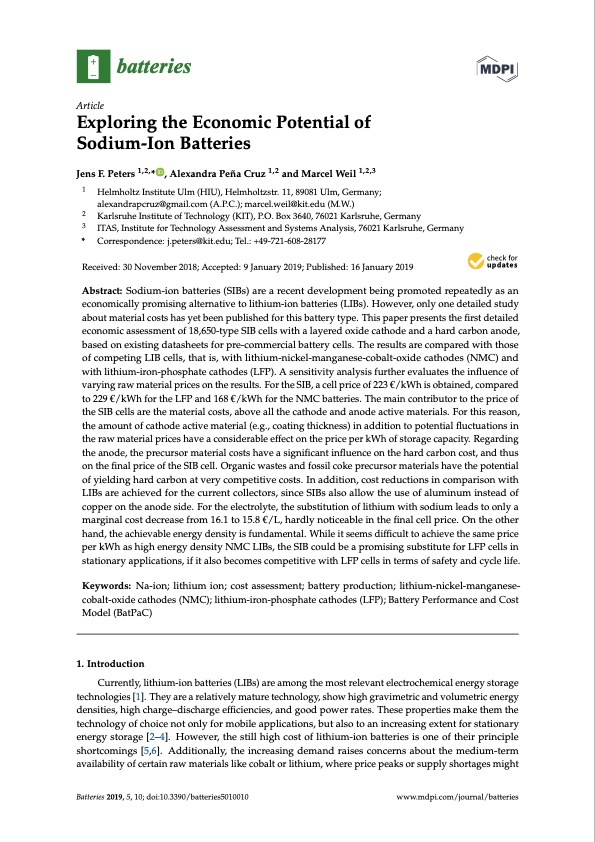
PDF Publication Title:
Text from PDF Page: 001
batteries Article Exploring the Economic Potential of Sodium-Ion Batteries Jens F. Peters 1,2,* , Alexandra Peña Cruz 1,2 and Marcel Weil 1,2,3 1 2 3 * Correspondence: j.peters@kit.edu; Tel.: +49-721-608-28177 Received: 30 November 2018; Accepted: 9 January 2019; Published: 16 January 2019 Helmholtz Institute Ulm (HIU), Helmholtzstr. 11, 89081 Ulm, Germany; alexandrapcruz@gmail.com (A.P.C.); marcel.weil@kit.edu (M.W.) Karlsruhe Institute of Technology (KIT), P.O. Box 3640, 76021 Karlsruhe, Germany ITAS, Institute for Technology Assessment and Systems Analysis, 76021 Karlsruhe, Germany Abstract: Sodium-ion batteries (SIBs) are a recent development being promoted repeatedly as an economically promising alternative to lithium-ion batteries (LIBs). However, only one detailed study about material costs has yet been published for this battery type. This paper presents the first detailed economic assessment of 18,650-type SIB cells with a layered oxide cathode and a hard carbon anode, based on existing datasheets for pre-commercial battery cells. The results are compared with those of competing LIB cells, that is, with lithium-nickel-manganese-cobalt-oxide cathodes (NMC) and with lithium-iron-phosphate cathodes (LFP). A sensitivity analysis further evaluates the influence of varying raw material prices on the results. For the SIB, a cell price of 223 €/kWh is obtained, compared to 229 €/kWh for the LFP and 168 €/kWh for the NMC batteries. The main contributor to the price of the SIB cells are the material costs, above all the cathode and anode active materials. For this reason, the amount of cathode active material (e.g., coating thickness) in addition to potential fluctuations in the raw material prices have a considerable effect on the price per kWh of storage capacity. Regarding the anode, the precursor material costs have a significant influence on the hard carbon cost, and thus on the final price of the SIB cell. Organic wastes and fossil coke precursor materials have the potential of yielding hard carbon at very competitive costs. In addition, cost reductions in comparison with LIBs are achieved for the current collectors, since SIBs also allow the use of aluminum instead of copper on the anode side. For the electrolyte, the substitution of lithium with sodium leads to only a marginal cost decrease from 16.1 to 15.8 €/L, hardly noticeable in the final cell price. On the other hand, the achievable energy density is fundamental. While it seems difficult to achieve the same price per kWh as high energy density NMC LIBs, the SIB could be a promising substitute for LFP cells in stationary applications, if it also becomes competitive with LFP cells in terms of safety and cycle life. Keywords: Na-ion; lithium ion; cost assessment; battery production; lithium-nickel-manganese- cobalt-oxide cathodes (NMC); lithium-iron-phosphate cathodes (LFP); Battery Performance and Cost Model (BatPaC) 1. Introduction Currently, lithium-ion batteries (LIBs) are among the most relevant electrochemical energy storage technologies [1]. They are a relatively mature technology, show high gravimetric and volumetric energy densities, high charge–discharge efficiencies, and good power rates. These properties make them the technology of choice not only for mobile applications, but also to an increasing extent for stationary energy storage [2–4]. However, the still high cost of lithium-ion batteries is one of their principle shortcomings [5,6]. Additionally, the increasing demand raises concerns about the medium-term availability of certain raw materials like cobalt or lithium, where price peaks or supply shortages might Batteries 2019, 5, 10; doi:10.3390/batteries5010010 www.mdpi.com/journal/batteriesPDF Image | Exploring the Economic Potential of Sodium-Ion Batteries

PDF Search Title:
Exploring the Economic Potential of Sodium-Ion BatteriesOriginal File Name Searched:
Exploring_the_Economic_Potential_of_Sodium-Ion_Bat.pdfDIY PDF Search: Google It | Yahoo | Bing
Salgenx Redox Flow Battery Technology: Salt water flow battery technology with low cost and great energy density that can be used for power storage and thermal storage. Let us de-risk your production using our license. Our aqueous flow battery is less cost than Tesla Megapack and available faster. Redox flow battery. No membrane needed like with Vanadium, or Bromine. Salgenx flow battery
| CONTACT TEL: 608-238-6001 Email: greg@salgenx.com | RSS | AMP |